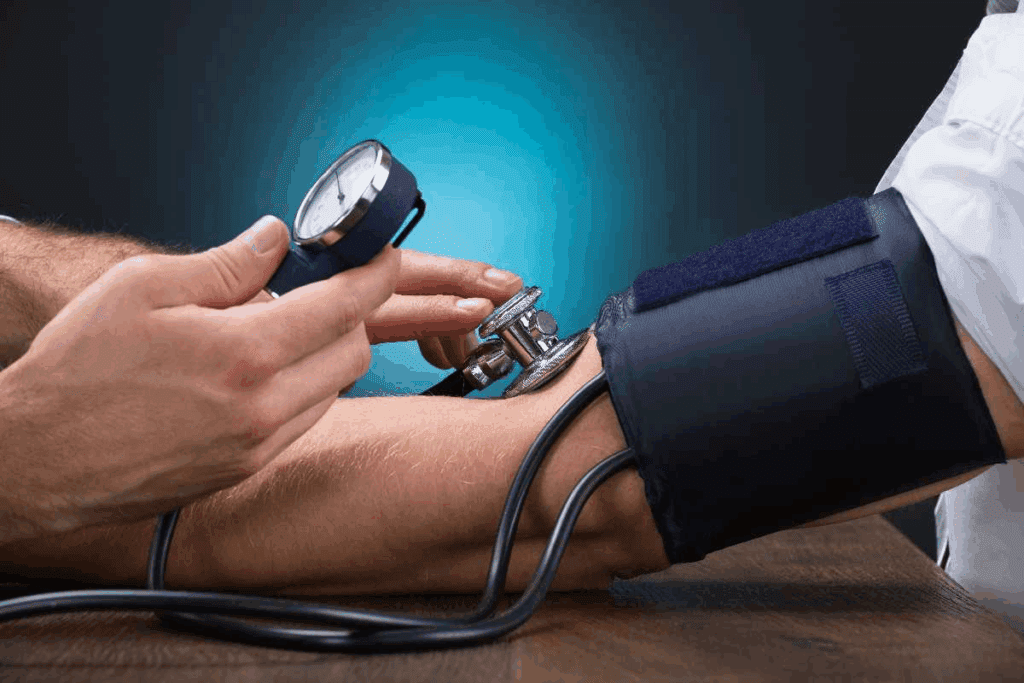
Your heart depends a lot on the left main coronary artery for most of its blood. At Liv Hospital, we know how important this artery is for heart health.
The left coronary artery splits into two main branches. These are the left anterior descending artery and the circumflex artery. They are key in getting oxygen-rich blood to the heart’s left side.
We are committed to giving top-notch medical care to international patients. Our team of experts is ready to offer world-class healthcare with full support.

Learning about coronary circulation helps us understand how the heart works and stays healthy. This complex network supplies blood directly to the heart muscle. It lets the heart pump blood all over the body efficiently.
The heart needs oxygen and nutrients to work right. The coronary arterial system, starting from the aorta, provides this. The left coronary artery is key as it feeds the left side of the heart.
Coronary blood flow is key because it brings oxygen and nutrients to the heart. Without it, the heart can’t pump blood well. This can cause heart attacks. So, keeping the coronary circulation healthy is essential for the heart.
The coronary arterial system includes several important arteries. The left main coronary artery splits into the LAD and LCX. These arteries feed different parts of the heart. Knowing about these arteries is vital for treating heart disease.
Coronary circulation is vital for heart health. It’s important for doctors and patients to know about it to fight and manage heart disease.

Knowing how the left main coronary artery works is key to spotting heart problems. This artery, or LM artery, is a vital blood vessel. It starts from the left aortic sinus of the aorta.
The left main coronary artery begins in the left aortic sinus, just above the aortic valve. It then moves between the pulmonary trunk and the left atrial appendage. It’s usually 3 to 6 mm wide and 5 to 10 mm long.
Its path is important because it’s near big heart parts. This makes it more likely to get hurt or blocked.
The left main coronary artery is usually short, under 10 mm long. But it can vary. It’s also wider than its branches, which helps it carry a lot of blood.
Its size and length are key to its job. Any changes can affect the heart’s health.
The left main coronary artery is close to important heart parts. It’s next to the pulmonary trunk and the left atrial appendage. Its branches feed the left ventricle, which pumps blood.
Knowing how this artery relates to heart parts is important. It helps us diagnose and treat heart disease. We must think about these connections when we check the heart’s function and plan treatments.
The left coronary system has key branches vital for heart function. These branches are essential for supplying blood to different heart parts, ensuring it works right.
The Left Anterior Descending Artery, or LAD, is a major branch of the left coronary artery. It runs down the heart’s anterior interventricular groove to the apex. It supplies blood to the left ventricle’s anterior wall, the interventricular septum’s anterior two-thirds, and sometimes the heart’s apex.
The LAD is very important because it supplies a lot of blood to the left ventricle. This is a big chamber of the heart. If the LAD gets blocked, it can cause serious heart damage. That’s why it’s called the “widow maker.”
The Left Circumflex Artery, or LCX, is another key branch of the left coronary artery. It goes through the left atrioventricular groove. It supplies blood to the left ventricle’s lateral and posterior walls, and the left atrium.
The LCX is vital for keeping the left ventricle’s lateral and posterior areas healthy. If it gets blocked, it can cause ischemia or infarction in these areas. This can lead to serious heart problems.
The Intermediate Branch, or Ramus Intermedius, is a variable branch that comes off the left coronary artery between the LAD and LCX. Its size and presence can vary a lot among people.
When it’s there, the Intermediate Branch supplies blood to the left ventricle’s lateral wall. It’s important because it can help with blood flow if other coronary arteries get blocked.
The left coronary artery’s branches work together to ensure the heart gets enough blood. Knowing about these branches is key for diagnosing and treating heart disease.
| Branch | Area Supplied | Clinical Significance |
| Left Anterior Descending Artery (LAD) | Anterior wall of left ventricle, anterior two-thirds of interventricular septum | Obstruction can lead to significant cardiac damage; known as “widow maker” |
| Left Circumflex Artery (LCX) | Lateral and posterior walls of left ventricle, left atrium | Obstruction can cause ischemia or infarction in supplied areas |
| Intermediate Branch (Ramus Intermedius) | Lateral wall of left ventricle (when present) | Provides collateral circulation; variable presence and size |
Understanding the areas the left main coronary artery supplies is key to knowing how the heart works. This artery splits into different paths, bringing blood to important heart parts.
The left ventricle is the heart’s main pumping chamber. It pumps blood full of oxygen to the body. The left main coronary artery’s branches, like the Left Anterior Descending Artery (LAD), mainly supply it.
The LAD runs along the heart’s front, reaching the left ventricle’s front, top, and some of the bottom. This blood supply is vital for the left ventricle to work right. Without it, the heart might fail or have irregular beats.
The left atrium gets blood from the lungs. It’s not as big as the left ventricle but is also important. The Left Circumflex Artery (LCX), a branch of the left main coronary artery, mainly feeds it.
The LCX reaches the left atrium’s sides and back. Keeping the left atrium well-perfused is key for the heart’s overall health.
The interventricular septum separates the left and right ventricles. It gets blood from both the left and right coronary arteries, mainly from the LAD. The LAD’s septal branches cover most of the septum.
The interventricular septum is vital for the heart’s electrical system. Its blood supply is essential for the heart to beat normally.
In summary, the left main coronary artery’s territories are vital for heart health. The left ventricle, left atrium, and interventricular septum all depend on it. Keeping the left main heart artery healthy is critical.
The left main coronary artery (LMCA) shows many different shapes and sizes. These differences are key for doctors to know. They help in diagnosing and treating heart disease.
The LMCA’s branches can vary a lot from person to person. Some people have more or larger branches like the left anterior descending artery (LAD) and the left circumflex artery (LCX). These changes can affect how blood flows to the heart.
For example, some might have a bigger LAD and a smaller LCX. Others might have them more evenly sized. Knowing these differences helps doctors read heart scans and plan treatments.
The LMCA’s length and size can also change a lot. A longer LMCA might be more prone to disease. A shorter one could make some treatments harder. The size of the LMCA can also change how blood flows and the risk of disease.
Research shows these differences matter a lot. For instance, a bigger LMCA might mean a higher risk of heart problems.
It’s very important to understand the LMCA’s variations for good care. These differences affect how we diagnose, treat, and manage heart disease. Knowing the LMCA’s specific shape and size helps doctors choose the best treatments.
We know how vital it is to consider these variations in our work. This way, we can give patients with heart disease the best care possible.
Left main coronary artery disease is a severe form of coronary artery disease. It happens when the left main coronary artery, which is key for heart blood supply, gets blocked.
This artery is important because it splits into the left anterior descending artery (LAD) and the left circumflex artery (LCX). These arteries supply a big part of the heart with blood. If this artery gets sick, it can cause serious heart damage or even death if not treated quickly.
Blockage of the left main coronary artery is very dangerous. It can greatly reduce blood flow to the heart, leading to a heart attack. The LAD, one of its branches, is often called the “widow maker” because of its high death rate.
A blockage in this artery can damage a lot of heart muscle. This can be fatal. That’s why getting medical help fast is so important.
“The left main coronary artery is a critical vessel that supplies blood to a significant portion of the heart. Disease in this artery can have severe consequences, making prompt diagnosis and treatment essential.”
It’s key to know the warning signs of left main coronary artery disease to get medical help fast. Common symptoms include:
If you have any of these symptoms, you should get medical help right away.
Several factors can lead to left main coronary artery disease, including:
| Risk Factor | Description |
| High Blood Pressure | High blood pressure can damage the coronary arteries. |
| High Cholesterol | High levels of LDL cholesterol can cause plaque buildup in the arteries. |
| Smoking | Smoking can damage the inner lining of blood vessels, making them more likely to block. |
| Diabetes | Diabetes can harm blood vessels and nerves, raising the risk of coronary artery disease. |
To prevent left main coronary artery disease, manage these risk factors through lifestyle changes and, if needed, medication. Regular health check-ups can help spot and manage risk factors early.
By knowing the risks and taking steps to prevent them, people can lower their chance of getting left main coronary artery disease and its serious complications.
It’s key to understand congenital anomalies of the left coronary artery. These rare issues can affect the heart’s blood flow and function. Knowing about them helps in diagnosing and treating heart problems.
There are different types of congenital anomalies of the left coronary artery. The most common ones include:
These anomalies can cause myocardial ischemia or infarction. Knowing the exact anomaly is key to finding the right treatment.
Left coronary artery anomalies often come with other heart issues. These can be:
These conditions make diagnosis and treatment harder. A detailed approach to care is needed.
Diagnosing left coronary artery anomalies is tough because they’re rare and varied. Tools like coronary angiography, CT angiography, and MRI are vital. They help spot the anomalies and plan treatment.
Managing left coronary artery anomalies depends on the anomaly and its effects. Treatment options include:
A team effort is essential for managing these complex cases. This team should include cardiologists, cardiothoracic surgeons, and other healthcare experts.
Advanced treatments for left main disease have changed how we manage this serious condition. At Liv Hospital, we use the latest medical tools and techniques. This approach helps us treat left main coronary artery disease effectively.
Medical management is key in treating left main disease. We focus on improving patient health by:
Interventional procedures are a less invasive option for many. Our options include:
Surgical revascularization is a top choice for complex left main disease. Our surgical methods include:
At Liv Hospital, we’re proud of our team approach. Our cardiologists, cardiac surgeons, and staff work together to:
By combining these advanced treatments and our team approach, we aim to give the best care to patients with left main coronary artery disease.
Keeping your coronary health safe is key for a healthy heart. The left main coronary artery is vital for blood flow to the heart. It’s important to keep it healthy to avoid heart disease.
We’ve looked at why the left coronary artery matters, its role, and the dangers of disease. Knowing this helps you take steps to protect your heart.
Healthy habits, managing risks, and getting care from places like Liv Hospital are essential. Together, we can lower heart disease risks and keep your heart healthy.
At Liv Hospital, we offer top-notch healthcare and support for international patients. Choosing us means you’re in safe hands. We’ll help you keep your heart healthy.
The left main coronary artery is key for the heart. It brings oxygen and nutrients to a big part of the heart muscle. If it gets blocked, it can cause serious heart problems.
The left coronary artery has three main branches. These are the Left Anterior Descending Artery (LAD), the Left Circumflex Artery (LCx), and sometimes the Intermediate Branch (Ramus Intermedius). Each branch supplies different parts of the heart.
This artery feeds the left ventricle, left atrium, and the interventricular septum. These areas are vital for the heart’s pumping action and overall health.
Left main coronary artery disease is very dangerous. It affects a large part of the heart. Blockage can lead to severe heart attacks, heart failure, and even death, making it a “widowmaker.”
Symptoms include chest pain (angina), shortness of breath, and fatigue. In severe cases, it can cause a heart attack. It’s important to recognize these signs early for timely treatment.
Doctors use tests like coronary angiography and stress tests to diagnose. Imaging studies like echocardiography or cardiac MRI also help. These tests check the artery blockage and heart function.
Treatments include medications and procedures like angioplasty and stenting. Sometimes, surgery like coronary artery bypass grafting is needed. The choice depends on the disease’s severity and the patient’s health.
Yes, congenital anomalies can be treated. The treatment varies based on the anomaly and any heart conditions. It may include surgery, medical management, or interventional procedures.
To keep your heart healthy, eat well, exercise regularly, don’t smoke, and manage stress. Also, control conditions like high blood pressure and diabetes. Regular health check-ups are important too.
Liv Hospital uses a team approach for treating this disease. They combine advanced medical care, interventional cardiology, and surgery. This care is designed for international patients.
National Center for Biotechnology Information. (2025). Left Main Coronary Artery 7 Essential Facts About.
Subscribe to our e-newsletter to stay informed about the latest innovations in the world of health and exclusive offers!
WhatsApp us